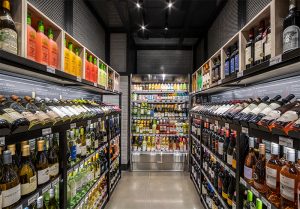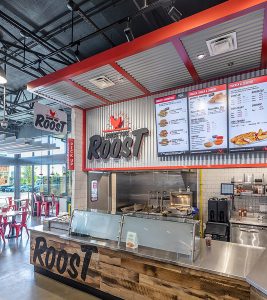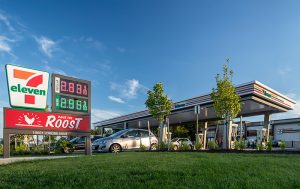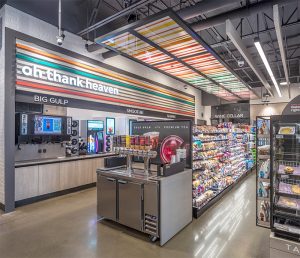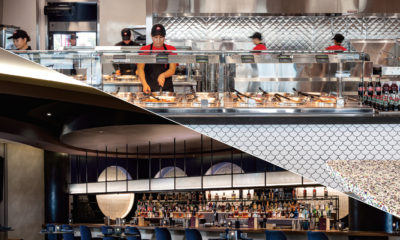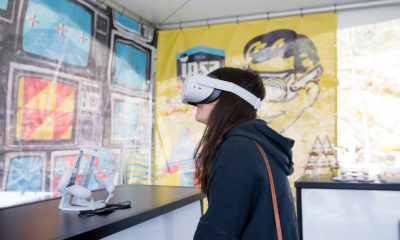THE PAST 18 months have thrown the rule book out for convenience stores. With lockdowns enforced globally and demand for in-and-out grocery shopping at an all-time high, convenience stores pivoted swiftly and successfully to stay afloat.
“During the pandemic, convenience stores not only survived but thrived as many other forms of retail shut down,” says Joseph Bona, Principal and Founder at Bona Design Lab (Secaucus, N.J.). “They showed versatility and flexibility by shifting their focus to household items and basic necessities like milk and bread.”
And with social distancing and touch-free shopping suddenly standard, store design has shifted to meet this change in expectations. “More and more we see layouts designed to provide a precise way of guiding customers through space with minimal obstacles and barriers. They’re thoughtful, curated, decluttered spaces with wider aisles and better sightlines,” Bona says.
Digital integration has also come to the fore, with corner stores and fast-food joints utilizing technology to enhance convenience and speed of transactions. “Chains like Wawa are experimenting with drive thru-only formats, which could have implications for smaller real estate footprints to allow for growth into new locations with lower operating costs. In fact, mobile order pick-up points, self-checkouts and contactless technologies are what we expect will have the biggest impact on future store design,” explains Bona.
Advertisement

Aldi’s Corner Store flagship in North Sydney, Australia, helps the brand get closer to its customers – emotionally and physically.
A MODEL OF CONVENIENCE
For Aldi’s (Essen Germany) Corner Store flagship in North Sydney, Australia, the pandemic meant getting closer to customers in a densely populated area – both emotionally as a brand and physically as a destination for necessities. That was the design directive Landini Associates (Sydney) held in mind when they devised a “genuinely local concept; one that acknowledges its location, neighborhood and their fresh food and grocery needs while still remaining recognizably Aldi,” says Ben Goss, Graphic Design Director at Landini Associates. Aldi’s signature color palette features heavily in the store, drawing the eye to key products.
Advertisement
Signage is bold and clear, reassuring customers that they can grab and go, while self-service stations for products like juice make for shopping with minimal interaction. Even in the compact space, walkways are open and airy, against a backdrop of sustainable materials including terrazzo, galvanized steel mesh and timber pallets that are used across Aldi stores to create a consistent brand atmosphere and customer experience.
“This past year emphasized that a small-format was not only desirable, but practical and helpful,” says Mark Landini, Creative Director, Landini Associates. “Unlike Aldi’s normal model, the building is an adaptive reuse, not a new-build or standalone site. It’s not the traditional ‘cookie cutter’ approach – It has more flexibility and ability to adapt.”
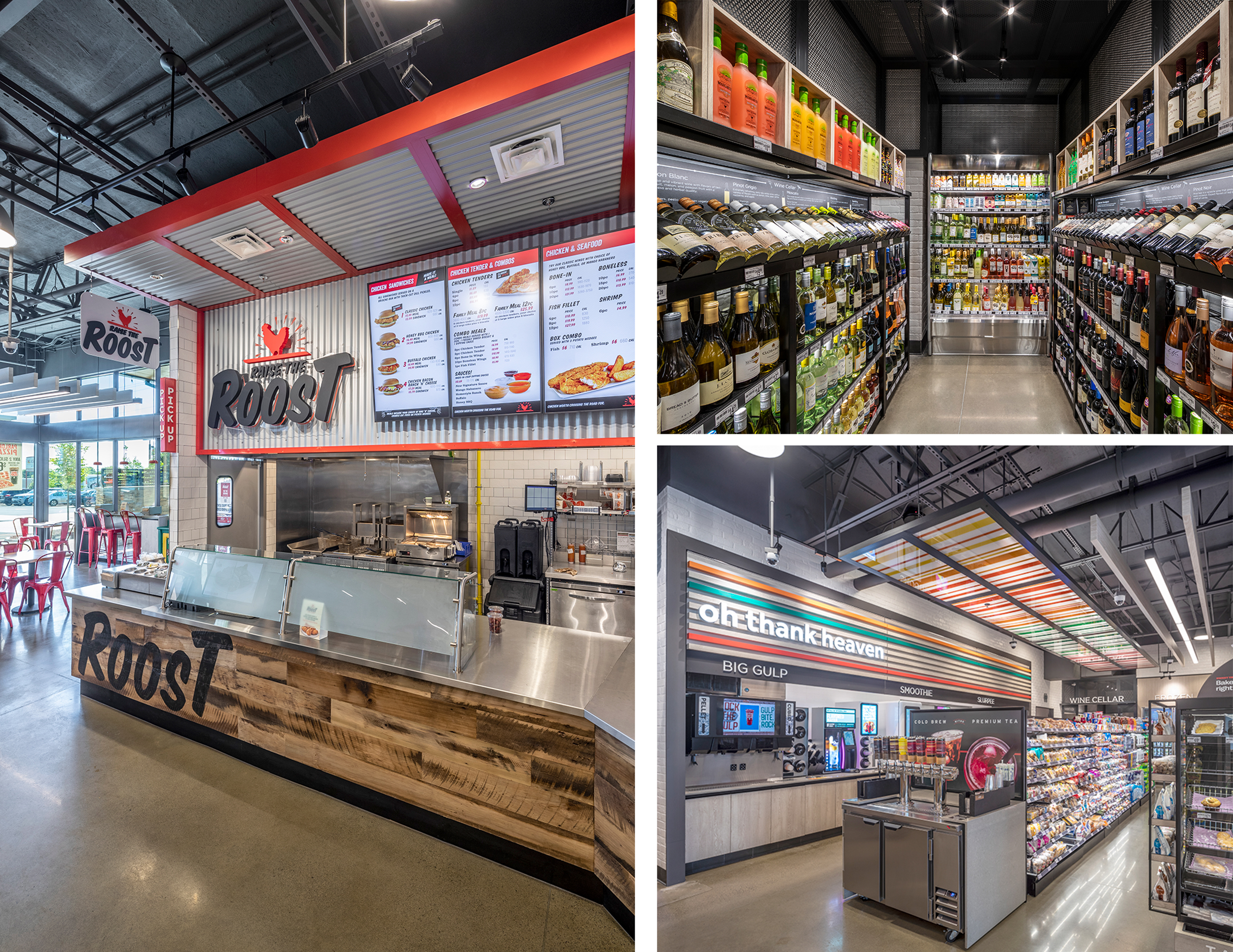
Social distancing played a significant role in the layout and fixture design of this new 7-Eleven flagship in Manassas, Va. | Photography: David Whitcomb/CallisonRTKL, Baltimore
SHORT AND SWEET
The 7-Eleven store in Manassas, Va., designed by CallisonRTKL (Baltimore), responded to changing circumstances by acknowledging shoppers’ safety and cleanliness concerns, says Billy Plummer, Principal at CallisonRTKL. “Social distancing played a big role in layout and fixture design. We created plenty of circulation space, with cup dispensers and condiment stations strategically placed to avoid clusters of people.”
The new flagship is the result of 10 years of evolution, without losing its iconic essence as a master of convenience. The new “7Now” delivery program, highlighted at the cashwrap, allows customers to order goods online to be delivered to their door. Mobile checkout stations are situated at the exit, so shoppers can pay quickly, minimizing time in store. “The interior is deliberately simple, serving as a backdrop for the brand highlights,” says Carlie Russell, Senior Designer, CallisonRTKL. “Concrete floors, brick and wood wall finishes and an exposed structure ceiling are paired with colorful accents to give hierarchy to distinct shopping zones. The architectural features and signage guide the customer’s eye for easy wayfinding, supporting a pleasant shopping experience.”
This experience is only enhanced by attention to detail in restroom design, roll-away fixtures and surfaces treated with an anti-microbial coating, “doing everything possible to provide a safe and clean environment” says Plummer.
Advertisement
Advertisement
As the retail world settles into a “new normal,” this adaptability will be essential. Convenience stores must now live up to their name, providing local, safe, easy experiences that meet changing needs. “Most supermarkets are neither ‘super’ nor ‘markets.’ They’ve become operationally driven product delivery systems and largely transactional,” says Landini. ““We hope that ALDI Corner Store addresses this and you leave with a smile.”
After the couple of years shoppers have endured, that might be just what they need.
PHOTO GALLERY (6 IMAGES)
(Aldi: Kyle Ford/Courtesy of Landini Associates, Surry Hill, Australia | 7-Eleven: David Whitcomb/CallisonRTKL, Baltimore)

 Photo Gallery7 days ago
Photo Gallery7 days ago
 Headlines7 days ago
Headlines7 days ago
 Headlines1 week ago
Headlines1 week ago
 Headlines2 weeks ago
Headlines2 weeks ago
 Headlines1 week ago
Headlines1 week ago
 Designer Dozen2 weeks ago
Designer Dozen2 weeks ago
 Designer Dozen5 days ago
Designer Dozen5 days ago
 Headlines6 days ago
Headlines6 days ago

